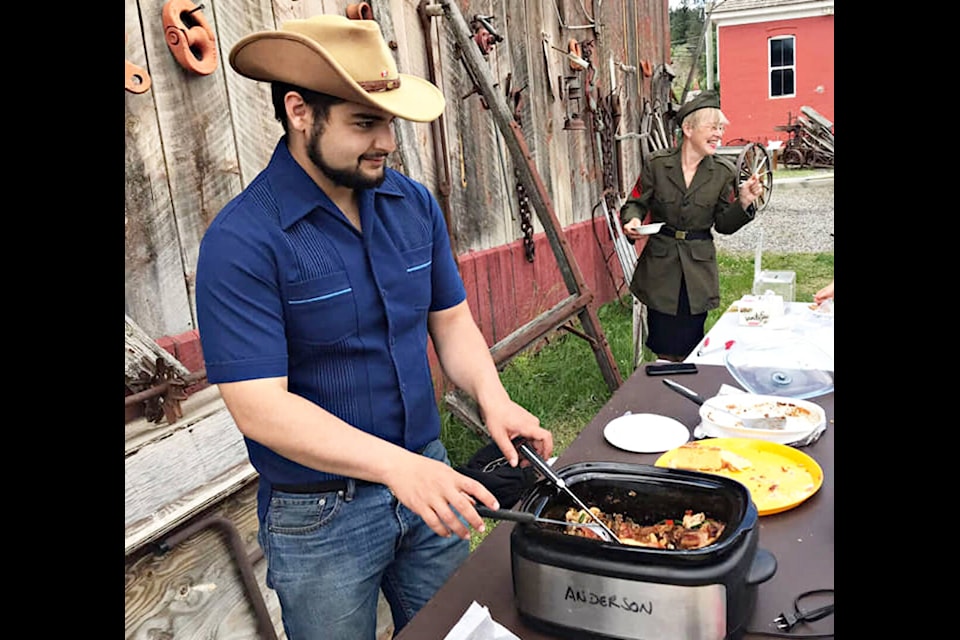All summer long, the Clinton Museum has been offering a literal “taste of the past”, with events that give participants a chance to sample authentic recipes from different eras.
The final event, which takes place at the museum on Saturday, Aug. 20, will feature eight different dishes from the lunch menu of the Clinton Hotel around 1958, shortly before the historic building — which had been serving travellers since 1860 — was destroyed by fire.
The museum staff and volunteers will be cooking one dish from each of eight categories that were on the lunch menu in 1958: relishes, soups, fish, salads, roasts and entrees, cold meats, vegetables, and sweets. The by-donation event is open to anyone, and one guest has already sent in an RSVP: Kamloops-Thompson-Cariboo MP Frank Caputo, who plans to be there on the 20th to sample the menu.
Nicholas Kosovic, the Clinton museum manager, says that the Clinton Hotel menu was chosen for the final event because it was such a meaningful establishment for the town for nearly a century.
“It’s a good one to end off on, because of the relative luxury the Clinton Hotel was able to offer for food and accommodation during the Gold Rush,” he explains. Many of the roadhouses built along the Cariboo Road were rough-and-ready affairs, offering a bed on the floor and a basic meal of bacon and beans, whereas the Clinton Hotel provided travellers with amenities — and meals — that were relatively scarce in the Interior for many years.
The event on Aug. 20 is the culmination of a series of historical food tasting events from various eras, from the Gold Rush days of the 1860s through the Depression and World War II years and up to the 1970s. Kosovic says that museum staff came up with the idea after realizing that “everyone loves food.
“We wanted something very simple that would be recurring, and this seemed like the perfect way to educate people about food, and its era, at different times.”
He says museum staff did a lot of research to come up with the recipes for the different events.
“We have several cookbooks from a variety of eras, and we checked online, since there are great resources there. We also drew from own families’ stores of recipes, especially for the 1930s and for wartime food.”
All the food was cooked by staff and volunteers. Kosovic says that the young museum staff hired through the Canada Summer Jobs program got help from their parents, as they didn’t have too much experience with cooking.
“It was a good way to teach them a skill that has lived on through generations. It puts us in the mindset that many people were in when they were trying to feed themselves. They had very basic wants, and it helps us relate to people who lived in this region.
“Food has a real way of connecting us when we look through old family recipes.”
People were assigned different foods, then sourced the ingredients, which wasn’t always easy. “When you look at some old recipe books you don’t recognize some ingredients. Sometimes we had to improvise, because they don’t make them like they used to. For instance, you can’t get blueberry bear fat, so we had to use more modern ingredients to fill some gaps.”
Food was locally sourced as much as possible, with staff going out into the field to pick Saskatoon berries. Kosovic says that while they did “spruce up” some of the recipes — adding more spices from what’s available today — some of the food was not all that delicious on purpose.
“We wanted to represent the scarcity of food during the times we’re covering. There was rationing during World War II, and scarcity during the Gold Rush.”
He adds that the actual recipes they used were something of a mixed bag.
“Some of them live on in modern menus, and then you have things like the mock apple pie from the Depression era, which replaces apples with Ritz crackers. That shocked people, but it tasted really good. Some of the recipes did make you think twice about what you should try out, though.”
The Clinton Hotel meal on Aug. 20 will not be served in the traditional style, where people order what they want. Instead, everyone will get to try a little bit of everything, with each item capturing a different category from the menu. The event starts at noon and runs until 2 p.m. or when the food runs out, so those who want to try everything should come early. There will be a chance to sample foods from the 1970s the week before, on Aug. 13, also from noon to 2 p.m.
“People love it,” says Kosovic. “They enjoy that it’s home-cooked, and it’s nice to have people have a chance to come together as a community to chat and try some new food.
“People don’t come to a museum expecting to be fed or see a spotlight on food. We’ve had people say ‘I haven’t had that in ages’ or ‘My grandmother used to make that on the Prairies.’ It’s been special for us as a staff to come together, and it’s really given working at the museum this summer a very positive vibe.”
He adds that the food events, along with other museum activities, have really had an impact.
“I’m hearing a lot of ‘The museum has come alive this summer.’ People who live in town have a reason to come once or twice a week to see something new and talk about history. It’s a community museum, and everything here comes from the community.”
editorial@accjournal.ca
Like us on Facebook and follow us on Twitter
